View in other NatureServe Network Field Guides
NatureServe
Montana
Utah
Wyoming
Idaho
Wisconsin
British Columbia
South Carolina
Yukon
California
New York
Tea-leaved Willow - Salix planifolia
Other Names:
Salix phylicifolia ssp. planifolia
Native Species
Global Rank:
G5
State Rank:
S4
C-value:
7
Agency Status
USFWS:
USFS:
BLM:
External Links
General Description
Shrubs 0.5–2 m. Twigs glabrous, black to reddish, shiny. Leaf blades 1–7 cm long, elliptic with entire margins; shiny green above, glaucous below. Female catkins 1–4 cm long, emerging before the leaves, sessile; scales black, long-hairy. Capsules 3–5 mm long, densely pubescent; stipes up to 1 mm long; style ca. 1 mm long (
Lesica et al. 2012. Manual of Montana Vascular Plants. BRIT Press. Fort Worth, TX).
Species Range
Montana Range
Range Descriptions

 Native
Native
Range Comments
YT to NL south to CA, NM and MN (Lesica et al. 2012. Manual of Montana Vascular Plants. BRIT Press. Fort Worth, TX).
Observations in Montana Natural Heritage Program Database
Number of Observations: 234
(Click on the following maps and charts to see full sized version)
Map Help and Descriptions
Relative Density
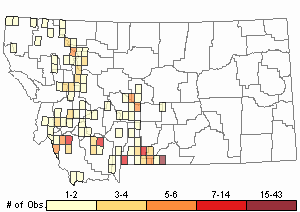
Recency
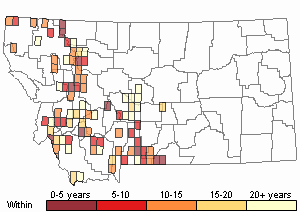
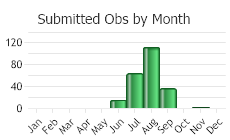
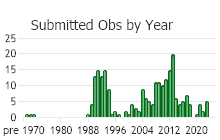
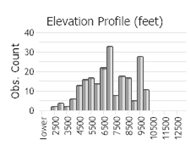 (Observations spanning multiple months or years are excluded from time charts)
(Observations spanning multiple months or years are excluded from time charts)
Habitat
National Vegetation Classification System Groups Associated with this Species
Wetland and Riparian
Alpine Riparian and Wetland
Peatland
Riparian Shrubland
Ecology
POLLINATORS The following animal species have been reported as pollinators of this plant species or its genus where their geographic ranges overlap:
Bombus vagans,
Bombus bifarius,
Bombus fervidus,
Bombus frigidus,
Bombus huntii,
Bombus melanopygus,
Bombus ternarius,
Bombus terricola,
Bombus sitkensis,
Bombus occidentalis,
Bombus pensylvanicus,
Bombus bimaculatus,
Bombus griseocollis,
Bombus impatiens, and
Bombus suckleyi (Plath 1934, Macior 1968, Heinrich 1976, Thorp et al. 1983, Colla and Dumesh 2010, Colla et al. 2011, Koch et al. 2012, Williams et al. 2014).
Stewardship Responsibility
References
- Literature Cited AboveLegend:
 View Online Publication
View Online Publication Colla, S., L. Richardson, and P. Williams. 2011. Bumble bees of the eastern United States. Washington, DC: USDA Forest Service, Pollinator Partnership. 103 p.
Colla, S., L. Richardson, and P. Williams. 2011. Bumble bees of the eastern United States. Washington, DC: USDA Forest Service, Pollinator Partnership. 103 p. Colla, S.R. and S. Dumesh. 2010. The bumble bees of southern Ontario: notes on natural history and distribution. Journal of the Entomological Society of Ontario 141:39-68.
Colla, S.R. and S. Dumesh. 2010. The bumble bees of southern Ontario: notes on natural history and distribution. Journal of the Entomological Society of Ontario 141:39-68. Koch, J., J. Strange, and P. Williams. 2012. Bumble bees of the western United States. Washington, DC: USDA Forest Service, Pollinator Partnership. 143 p.
Koch, J., J. Strange, and P. Williams. 2012. Bumble bees of the western United States. Washington, DC: USDA Forest Service, Pollinator Partnership. 143 p. Lesica, P., M.T. Lavin, and P.F. Stickney. 2012. Manual of Montana Vascular Plants. Fort Worth, TX: BRIT Press. viii + 771 p.
Lesica, P., M.T. Lavin, and P.F. Stickney. 2012. Manual of Montana Vascular Plants. Fort Worth, TX: BRIT Press. viii + 771 p. Macior, L.M. 1968. Bombus (Hymenoptera, Apidae) queen foraging in relation to vernal pollination in Wisconsin. Ecology 49:20-25.
Macior, L.M. 1968. Bombus (Hymenoptera, Apidae) queen foraging in relation to vernal pollination in Wisconsin. Ecology 49:20-25. Plath, O.E. 1934. Bumblebees and their ways. New York, NY: Macmillan Company. 201 p.
Plath, O.E. 1934. Bumblebees and their ways. New York, NY: Macmillan Company. 201 p. Thorp, R.W., D.S. Horning, and L.L. Dunning. 1983. Bumble bees and cuckoo bumble bees of California (Hymenoptera: Apidae). Bulletin of the California Insect Survey 23:1-79.
Thorp, R.W., D.S. Horning, and L.L. Dunning. 1983. Bumble bees and cuckoo bumble bees of California (Hymenoptera: Apidae). Bulletin of the California Insect Survey 23:1-79. Williams, P., R. Thorp, L. Richardson, and S. Colla. 2014. Bumble Bees of North America. Princeton, NJ: Princeton University Press. 208 p.
Williams, P., R. Thorp, L. Richardson, and S. Colla. 2014. Bumble Bees of North America. Princeton, NJ: Princeton University Press. 208 p.
- Additional ReferencesLegend:
 View Online Publication
View Online Publication
Do you know of a citation we're missing? Argus, G. 2010. Salix. In: Flora of North America Editorial Committee, eds. 1993+. Flora of North America North of Mexico. 16+ vols. New York and Oxford. Vol. 7.
Argus, G. 2010. Salix. In: Flora of North America Editorial Committee, eds. 1993+. Flora of North America North of Mexico. 16+ vols. New York and Oxford. Vol. 7. Barge, E.G. 2015. Systematics of Lactarius in the Rocky Mountain alpine zone. M.Sc. Thesis. Bozeman, MT: Montana State University. 223 p.
Barge, E.G. 2015. Systematics of Lactarius in the Rocky Mountain alpine zone. M.Sc. Thesis. Bozeman, MT: Montana State University. 223 p. Barge, E.G., C. Cripps and T.W. Osmundson. 2016. Systematics of the ectomycorrhizal genus Lactarius in the Rocky Mountain alpine zone. Mycologia, 108(2), 2016, pp. 414–440. DOI: 10.3852/15-177
Barge, E.G., C. Cripps and T.W. Osmundson. 2016. Systematics of the ectomycorrhizal genus Lactarius in the Rocky Mountain alpine zone. Mycologia, 108(2), 2016, pp. 414–440. DOI: 10.3852/15-177 Burkholder, B.O. 2015. Seasonal distribution, winter habitat selection and willow utilization patterns of the Shiras Moose on the Mount Haggin Wildlife Management Area. M.Sc. Thesis. Bozeman, Montana: Montana State University. 262 p.
Burkholder, B.O. 2015. Seasonal distribution, winter habitat selection and willow utilization patterns of the Shiras Moose on the Mount Haggin Wildlife Management Area. M.Sc. Thesis. Bozeman, Montana: Montana State University. 262 p. Burkholder, B.O., N.J. DeCesare, R.A. Garrot, and S.J. Boccadori. 2017. Heterogeneity and power to detect trends in Moose browse utilization of willow communities. ALCES 53:23-29.
Burkholder, B.O., N.J. DeCesare, R.A. Garrot, and S.J. Boccadori. 2017. Heterogeneity and power to detect trends in Moose browse utilization of willow communities. ALCES 53:23-29. Cripps, C.L., U. Eberhardt, N. Schutz, H.J. Beker, V.S. Evenson, and E. Horak. 2019. The genus Hebeloma in the Rocky Mountain alpine zone. MycoKeys 46: 1-54. https://doi.org/10.3897/mycokeys.46.32823
Cripps, C.L., U. Eberhardt, N. Schutz, H.J. Beker, V.S. Evenson, and E. Horak. 2019. The genus Hebeloma in the Rocky Mountain alpine zone. MycoKeys 46: 1-54. https://doi.org/10.3897/mycokeys.46.32823 Dorn, R.D. 2010. The genus Salix in North America north of Mexico. 59 pp.
Dorn, R.D. 2010. The genus Salix in North America north of Mexico. 59 pp. Forcella, F. 1977. Flora, chorology, biomass and productivity of the Pinus albicaulis-Vaccinium scoparium association. M.S. Thesis. Bozeman, MT: Montana State University. 99 pp.
Forcella, F. 1977. Flora, chorology, biomass and productivity of the Pinus albicaulis-Vaccinium scoparium association. M.S. Thesis. Bozeman, MT: Montana State University. 99 pp. Law, D.J. 1999. A comparison of water table dynamics and soil texture under black cottonwood recent alluvial bar, beaked sedge, and Geyer's/Drummond's willow communities. M.Sc. Thesis. Bozeman, MT: Montana State University. 68 p.
Law, D.J. 1999. A comparison of water table dynamics and soil texture under black cottonwood recent alluvial bar, beaked sedge, and Geyer's/Drummond's willow communities. M.Sc. Thesis. Bozeman, MT: Montana State University. 68 p. Lesica, P., M.T. Lavin, and P.F. Stickney. 2022. Manual of Montana Vascular Plants, Second Edition. Fort Worth, TX: BRIT Press. viii + 779 p.
Lesica, P., M.T. Lavin, and P.F. Stickney. 2022. Manual of Montana Vascular Plants, Second Edition. Fort Worth, TX: BRIT Press. viii + 779 p. Little, E.L., Jr. 1979. Checklist of United States trees (native and naturalized). Agriculture Handbook No. 541. U.S. Forest Service, Washington, D.C. 375 pp.
Little, E.L., Jr. 1979. Checklist of United States trees (native and naturalized). Agriculture Handbook No. 541. U.S. Forest Service, Washington, D.C. 375 pp. Noffsinger, C.R. 2020. Systematic analysis of Russula in the North American Rocky Mountain alpine zone. M.Sc. Thesis. Bozeman, MT: Montana State University. 277 p.
Noffsinger, C.R. 2020. Systematic analysis of Russula in the North American Rocky Mountain alpine zone. M.Sc. Thesis. Bozeman, MT: Montana State University. 277 p. Osmundson, T.W. 2003. Systematics of Rocky Mountain alpine Laccaria (basidiomycota, agaricales, tricholomataceae) and ecology of Beartooth Plateau alpine macromycetes. M.Sc. Thesis. Bozeman, MT: Montana State University. 188 p.
Osmundson, T.W. 2003. Systematics of Rocky Mountain alpine Laccaria (basidiomycota, agaricales, tricholomataceae) and ecology of Beartooth Plateau alpine macromycetes. M.Sc. Thesis. Bozeman, MT: Montana State University. 188 p. Williams, K.L. 2012. Classification of the grasslands, shrublands, woodlands, forests and alpine vegetation associations of the Custer National Forest portion of the Beartooth Mountains in southcentral Montana. M.Sc. Thesis. Bozeman, MT: Montana State University. 376 p.
Williams, K.L. 2012. Classification of the grasslands, shrublands, woodlands, forests and alpine vegetation associations of the Custer National Forest portion of the Beartooth Mountains in southcentral Montana. M.Sc. Thesis. Bozeman, MT: Montana State University. 376 p.
- Web Search Engines for Articles on "Tea-leaved Willow"





